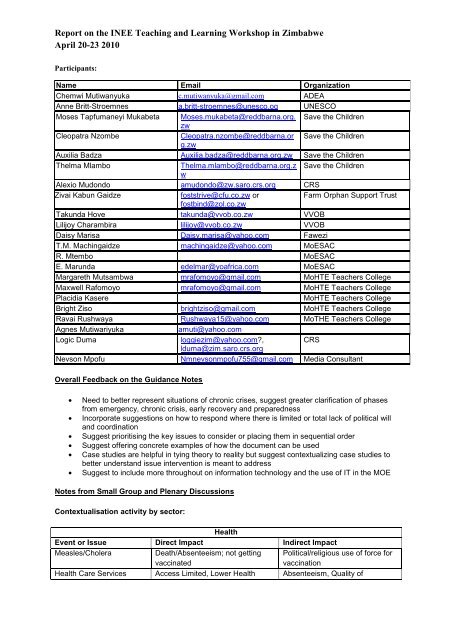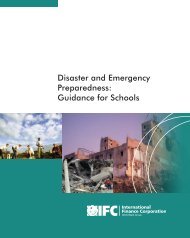Download - INEE
Download - INEE
Download - INEE
You also want an ePaper? Increase the reach of your titles
YUMPU automatically turns print PDFs into web optimized ePapers that Google loves.
Report on the <strong>INEE</strong> Teaching and Learning Workshop in ZimbabweApril 20-23 2010Participants:Name Email OrganizationChemwi Mutiwanyuka c.mutiwanyuka@gmail.com ADEAAnne Britt-Stroemnes a.britt-stroemnes@unesco.og UNESCOMoses Tapfumaneyi Mukabeta Moses.mukabeta@reddbarna.org. Save the ChildrenzwCleopatra NzombeCleopatra.nzombe@reddbarna.or Save the Childreng.zwAuxilia Badza Auxilia.badza@reddbarna.org.zw Save the ChildrenThelma MlamboThelma.mlambo@reddbarna.org.z Save the ChildrenwAlexio Mudondo amudondo@zw.saro.crs.org CRSZivai Kabun Gaidzefoststrive@cfu.co.zw orFarm Orphan Support Trustfostbind@zol.co.zwTakunda Hove takunda@vvob.co.zw VVOBLilijoy Charambira lilijoy@vvob.co.zw VVOBDaisy Marisa Daisy.marisa@yahoo.com FaweziT.M. Machingaidze machingaidze@yahoo.com MoESACR. Mtembo MoESACE. Marunda edelmar@yoafrica.com MoESACMargareth Mutsambwa mrafomoyo@gmail.com MoHTE Teachers CollegeMaxwell Rafomoyo mrafomoyo@gmail.com MoHTE Teachers CollegePlacidia KasereMoHTE Teachers CollegeBright Ziso brightziso@gmail.com MoHTE Teachers CollegeRavai Rushwaya Rushwaya15@yahoo.com MoTHE Teachers CollegeAgnes Mutiwariyukaamuti@yahoo.comLogic Dumaloggiezim@yahoo.com?,CRSlduma@zim.saro.crs.orgNevson Mpofu Nmnevsonmpofu755@gmail.com Media ConsultantOverall Feedback on the Guidance Notes• Need to better represent situations of chronic crises, suggest greater clarification of phasesfrom emergency, chronic crisis, early recovery and preparedness• Incorporate suggestions on how to respond where there is limited or total lack of political willand coordination• Suggest prioritising the key issues to consider or placing them in sequential order• Suggest offering concrete examples of how the document can be used• Case studies are helpful in tying theory to reality but suggest contextualizing case studies tobetter understand issue intervention is meant to address• Suggest to include more throughout on information technology and the use of IT in the MOENotes from Small Group and Plenary DiscussionsContextualisation activity by sector:HealthEvent or Issue Direct Impact Indirect ImpactMeasles/CholeraDeath/Absenteeism; not gettingvaccinatedPolitical/religious use of force forvaccinationHealth Care Services Access Limited, Lower Health Absenteeism, Quality of
Report on the <strong>INEE</strong> Teaching and Learning Workshop in ZimbabweApril 20-23 2010StandardEducationHIV/AIDS Death, Drop Outs Child-Headedhomes/DiscriminationCorporal Punishment Death, Injuries Bad Teaching Methods, ParentsWorried, Bullying, AbsenteeismAbuse (Verbal and Sexual) Contracting HIV/AIDS, Pregnancy,STI’s, Emotional TraumaPerpetuate inequalities,deformities, absenteeismMalnutritionLow concentration, differentdiseases, low enrolment, stuntedgrowth, physical learning deficitsAbsenteeism, scavenging esp.girlchild, prostitution, brain drainChallenged, special needschildrenTraditional practicesSanitation (water, rubbish,air) and Power cutsLow access to quality educationL.E Ramos? Braille, Teaching AidsEarly marriage, genital mutilation,HIV/AIDS / no schoolingPoor health (diahhrea, air- andwater- born disease), risk ofinfection, environment pollution,delinquency, charcoal chestinfectionsCan’t compete with able-bodiedchildren, violation of childrensrightsAbsenteeism, drop-outs,stigmatizationIrresponsibility, perpetuation ofunclean environment, HIV/AIDSEducationEvent or Issue Direct Impact Indirect ImpactShortage ofteaching/learning materialsPoor quality education delivery,monotonous teaching methods (i.e.lecture)Absenteeism, dropouts, rise inilliteracy level, failure to ocmpetewith international studentsBrain DrainLack of skilled human resources,poor quality educationLow response to teacher trainingprogrammesUnmotivated staffLack of maintenance ofexisting infrastructureHalf-hearted lesson delivery byteachers, absenteeism of bothteacher and children, brain drainUnsafe learning environment, nonconduciveenvironment forlearning, presuure on ?Shortage of infrastructure innewly settled areasHit sitting?, Overcrowding,pressure ?Shortage of financialresourcesCorporal punishment Injuries, deaths Drop-outsShortage of ? resources No community ? within ministriesRise of abuse, rise of delinquentbehavior since children aren’tmonitored, early marriages, lowresponse to training programmesExposure to unhealthyconditions, over stretching of theparents’ duty bearers’ meagerresourcesSocialEvent or Issue Direct Impact Indirect ImpactHIV/AIDSIllness absenteeism and dropouts,caregiver child-headedfamilies, deathStigma of discrimination atschool, low performance
Report on the <strong>INEE</strong> Teaching and Learning Workshop in ZimbabweApril 20-23 2010PovertyGender stereotypingDomestic violenceNo fees/levids drop out, lack ofsupport material (books/uniforms),brain drainLess attention to girls education,biased teaching methods and/orselection of curriculumLack of conducive learningenvironment, violation of child’srights, psychological traumaUnder achievement, stigma anddiscrimination, lack of skilledteachersFemales less education thanmale counterparts poorparenting greater health,economic, social issuesLack of concentration in class,low performance, violent behaviorabsenteeism, withdrawal, truancyDisability (special needs) Exclusion Limited education can lead toilliteracy, curriculum not designedto accommodate for thesechildrenLanguage Communication barrier, exclusion Misunderstanding, unequalopportunities, illiteracy, inability toachieve national / global goalsCultural practices(circumcision)lonelinessEnvironmentalEvent or Issue Direct Impact Indirect ImpactDrought, floods, winds(natural disasters)Safety (displacement,violence, corporatepunishment, bullying)Agrigulture employmentInfrastructureFamilies move to look for food,casual labor, irregular attendanceto work by teachers,displacement**, malnutrition,general physical weakness, lossof life, closure of schools,desctruction of infrastructure (eg.Classrooms, communicationnetworks, roads, etc.), floods leadto disease outbreaks b/c ofairborne diseaseInsecurity, uncertainty for bothteacher and children,absenteeism, truancy, teachersmove and transfer (within andbeyond borders), abuse ofchildren and teachers, vandalismand looting of school propertiesChild labour (eg. In sugar, teaestates)Absenteeism, dropouts, poorperformance/concentration, childlabor, poor quality education,exploitation and abuse, interruptionof teaching/learning processChildren become potential abusers,loss of qualified and skilledpersonnel, lack of continuity, poorresultsPoor performance, erraticattendance, eventual drop-outEconomicEvent or Issue Direct Impact Indirect ImpactEvents of 1997 “blackFriday”, 1998 escapadeinto DRC and 1998Did not feel the direct impact then…But loss of life, parentsDifficulties in accessing foreigncurrency for buying educationalequipment, school dropouts due
Report on the <strong>INEE</strong> Teaching and Learning Workshop in ZimbabweApril 20-23 2010closure of bureau dechange led to the parallelmarketThe 1999 ‘no ref’ and theemergence of theopposition party ultimatelyled to invasion of farms,thereby destroying theeconomic base of ZimBetween 2000 to date, theabsence of experiencedfarmers and the presenceof inexperienced newfarmers led to lowproductivity and shortageof agricultural goodsDollarisationFarm schools closed, children notattending school, parents notemployed anymoreBrain-drain (teachers), low intake atTeacher.Training.Colleges, noresources (books, furniture,stationary, sporting facilities),increased funding for fiscust?, lowpass rates, very high drop-outs,inability to register for exams(o’level), unemployment for parents,prostitution (CSW) rural areas –family disintegration, displacementFailure to pay school fees, inequalityin teacher pay – incentives2005 Murabarsvin Vagrance and poverty, CSW – ruralareas, displacement of families, res?Resource pressures – cholerato students working asspeculatorsContravening the educationpolicy of “universal rights toeducation for all children”Lost generation (school leaverswith no academic background),reduced number of newlyqualified teachers to deployNeed to work hard oncurriculum to emphasizeproduction (mining, agriculture,manufacturing and tourism) toend up with local productionFamily disintegration
Report on the <strong>INEE</strong> Teaching and Learning Workshop in ZimbabweApril 20-23 2010SWOTs (Strengths, Weaknesses, Opportunities, Threats) AnalysisCurricula:Strengths• Department in Ministry dedicated toCurricula, a structure exists forcurriculareview and material development• Effective publishing industry withregionaland international reach• Basic curricula already in place fromwhich to build• Standards allow children/learners tomovebetween countries (int’l standards)• Technical stakeholdersidentified/availablefor each subject• Curriculum “Library” or depository• Structure is in place for M&E ofcurriculaimplementation• Standard national curricula• Support from NGOs who haveaccess tocurricula• ECD-Youth; all levels covered• Non-formal curricula for out-of-schoolyouth, children and adultsOpportunities• Current “crisis” leading to popularsupportfor education review• Commitment by government toeducation• Continued commitment of parents• Support from internationalorganizations• Existence of technical staff; increaseallocation of positions• Policies becoming more supportive ofcurricula change• Ratified EFA and MGDs• Ratified CRC• Signed AU second Decade of EducationWeaknesses• Not all stakeholders involved in curriculareview• Review not always comprehensive ortimely• Lack of funding for review• Weak link with teacher training/disconnectbetween national curricula and trainingcurricula/materials• Little data on curricula collected in EMIS• Lack of technical development forcurricula experts• Sub-national technical capacity needs tobe strengthened• Too few education inspectors• Logistics and funding not in place for M&E• Content of curricula not always relevant,esp. for health issues, civics education,and lifeskillsThreats• Political will doesn’t translate tofunding• Ministerial commitment exists but stilllack of broader political will• Global economic crisis=reducedinternational resources available• High unemployment in formalsector=less money for education• Lack of appropriate facilities• Movement of people out of Zim andcommunities, esp. educated people• Possibility of cholera outbreak• Poverty=can’t purchase schoolmaterials or support teacher incentives• Child-headed households• Language policy vs practiceTraining Section
Report on the <strong>INEE</strong> Teaching and Learning Workshop in ZimbabweApril 20-23 2010Strengths• Most teachers are qualified and trained• System allows for refresher training• Child-centred instruction encouraged• Teachers can communicate in languageof community• Strong parent & community involvement• Policy guidelines for instruction spaces,monitoring of spaces exists• NGOs advocating and supporting childfriendlyteaching practices• Teaching and learning resourcesavailable and appropriate• System to supervise teachers in place• Policies on inclusive educationWeaknesses• Corporal punishment still exists• Lack of teacher motivation• Large class sizes• Content lags behind context• Disparities between districts regardingPercentage of trained teachers• Disparity between rural/urban/resettled• Some settlements use inappropriatestructures• Teachers not always able/motivated touse child-friendly practices• Exam-oriented/lack time for lifeskills andextra-curricular• Parents unable/unmotivated to helpstudents with homework• Inadequate numbers of learningmaterials• Lack of furniture in some schools• Lack of resources for supervision• Implementation of inclusive education isweak (resources and training)Opportunities• Globalization=increased info andopportunities• Advocacy from NGOs on child-centredapproaches, child rights, child protection,child participation• Increase in infectious diseases providesopportunity to teach health issues• Increased call for the above bycommunities and government as well• More instruction to address health issues• Rights-based approach to child rights• EFA, CRC, MDGs, AU ratified• Parents providing monetary incentives toteachers• Positive change in corporal punishmentThreats• Economic situation and global crisis=lack of resources• Shadow tutoring• HIV/AIDS and other infectious diseasesimpacts population• Some communities not aware ofchildren’s rights• Children’s rights not always respected inclassroom (weakness)• Monetary incentives to teachers notequitable• Natural disasters and climate change =displacement, disruption andabsenteeism, esp. for girls• Lack of nutritionAssessment of Learning Outcomes
Report on the <strong>INEE</strong> Teaching and Learning Workshop in ZimbabweApril 20-23 2010Strengths• ZIMSEC – schools examinationcouncil (attaché to ministry) isoperational• All age levels of learners are coveredby national exams• Database is available to collectassessment data• Classroom exams are consistent• Teachers receive training onassessment (both qualitative andquantitative)• There is a system for communicationbetween teachers and parentsabout student achievement• Teachers are trained to make booksand keep student records• There is a standard for assessmentin the Curricula.• Primary school training covers socialand emotional learning assessment• System in place to monitorassessment processes• System for supervision ofassessment is established withinschoolsOpportunities• Interest in strengthening ZIMSEC• SDC in many areas are asking formore information on studentachievement• SDC is a link b/w community andschool that can be mobilised• Zimbabwe has signed on to MDGs,EFA, AU, indicating some politicalwill to measure learningachievements• Policy in place that everyone isallowed to sit for exams regardlessof ability to payWeaknesses• Lack of ZIMSEC and otherassessment staff motivation• Teachers not compensated well formarking• Exam records, assignment of gradesand registration records are notaccurate• Database, while available, is underoperationsdue to lack of funding• Not all teachers are trained inassessment, esp. in the remoteareas• Communication with parents is notconsistent• National exams are overemphasizedabove all else so students aren’talways prepared for the “real world”and livelihoods• Temporary supervision• Action not taken on data collecteddue to lack of resources• Secondary school teachers have lesstraining on how to assess social andemotional learning• Lack of funding and humanresources to monitor the assessmentprocess• Ratio of DEO to teachers isinadequate• Automatic progression policy throughform 2Threats• ZIMSEC certificate not recognised asmuch by other countries as in the past• There is a preference for Cambridgecertificate• Overall the quality of education inZimbabwe is seen as lower thanbefore• Unstable economic situation government resources don’t alwaysmatch political will / misappropriationof funds / if you can’t pay fees you aresometimes not allowed to sit forexams• Nepotism for jobs – who you know ismore important than merit esp.achievement in school
















